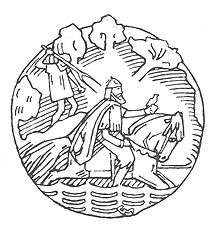Ynglinga saga
Ynglinga saga is a legendary saga, originally written in Old Norse by the Icelandic poet and historian Snorri Sturluson about 1225. It is the first section of his Heimskringla. It was first translated into English and published in 1844 by Samuel Laing.

|
Hrólf Kraki Tradition |
| Hrólf Kraki's saga |
| Ynglinga saga |
| Lejre Chronicle |
| Gesta Danorum |
| Beowulf |
| People |
| Hrólfr Kraki |
| Halfdan |
| Helgi |
| Yrsa |
| Adils |
| Áli |
| Bödvar Bjarki |
| Hjörvard |
| Roar |
| Locations |
| Lejre |
| Uppsala |
| Fyrisvellir |
Snorri Sturluson based his work on an earlier Ynglingatal which is attributed to the Norwegian 9th-century skald Þjóðólfr of Hvinir, and which also appears in Historia Norwegiae. It tells the most ancient part of the story of the House of Ynglings (Scylfings in Beowulf). Snorri described the descent of the kings of Norway from this royal house of Sweden.
Ynglinga saga is the first part of Snorri's history of the ancient Norse kings, the Heimskringla. Snorri's work covers the history of the Norwegian kings from the mythical prehistoric age until 1177, with the death of the pretender Eystein Meyla. Interwoven in this narrative are references to important historical events.
The saga deals with the arrival of the Norse gods to Scandinavia and how Freyr founded the Swedish Yngling dynasty at Uppsala. Then the saga follows the line of Swedish kings until Ingjald (Ingjald illråde), after which the descendants settled in Norway and became the ancestors of the Norwegian King Harald Fairhair.
In the initial stanzas of the poem, Asagarth is the capital of Asaland, a section of Asia to the east of the Tana-kvísl or Vana-Kvísl river (kvísl is "fork"), which Snorri explains is the Tanais, or Don River, flowing into the Black Sea. The river divides "Sweden the Great", a concession to the Viking point of view. It is never called that prior to the Vikings (Section 1).
Synopsis
Odin is the chief of Asgard. From there he conducts and dispatches military expeditions to all parts of the world. He has the virtue of never losing a battle (Section 2). When he is away, his two brothers, Vili and Vé, rule Ásaland from Ásgarðr.
On the border of Sweden is a mountain range running from northeast to southwest. South of it are the lands of the Turks, where Odin had possessions; thus, the mountains must be the Caucasus Mountains. On the north are the uninhabitable fells, which must be the tundra/taiga country. Apparently, the Vikings did not encounter the Urals or the peoples of the region. Snorri evidences no knowledge of them.
There also is no mention of Troy, which was not far from Constantinople, capital of the Byzantine empire and militarily beyond the reach of the Vikings. Troy cannot have been Asagarth, Snorri realizes, the reason being that the Æsir in Ásaland were unsettled by the military activities of the Romans; that is, of the Byzantine Empire.
As a result, Odin led a section of the Æsir to the north looking for new lands in which to settle. They used the Viking route up the Don and the Volga through Garðaríki, Viking for Kievan Rus'. From there they went to Saxland (Germany) and to the lands of Gylfi in Scandinavia (Section 5). The historical view, of course, is mainly fantastical. The Germanics were in Germany and Scandinavia during earliest mention of them in Roman literature, long before the Romans had even conquered Italy. To what extent Snorri's presentation is poetic creation only remains unclear.
Demoted from his position as all-father, or king of the gods, Odin becomes a great sorcerer in the Ynglinga Saga. He can shape-shift, speaks only in verse, and lies so well that everything he says seems true. He strikes enemies blind and deaf and when his own men fight they go berserk and cannot be harmed. He has a ship that can be rolled up like a tablecloth when not used, he relies on two talking ravens to gather intelligence, and he consults the talking head of Mimir for advice (he carries it around long since detached from its body) (Section 7).
As a man, Odin is faced with the necessity to die. He is cremated and his possessions are burned with him so that he can ascend to - where? If Asgard is an earthly place, not there. Snorri says at first it is Valhalla and then adds: "The Swedes now believed that he had gone to the old Asagarth and would live there forever" (Section 9).
Sources
- Krag, Claus Ynglingatal og Ynglingesaga- en studie i historiske kilder (1991)
- Nerman, Birger Det svenska rikets uppkomst (Stockholm, 1925)
- Åkerlund, W. Studier över Ynglingatal (Lund, 1939)
External links
- Ynglinga saga and Heimskringla from «Kulturformidlingen norrøne tekster og kvad» Old Icelandic
- Heimskringla: The Ynglinga Saga from The Medieval and Classical Literature Library English